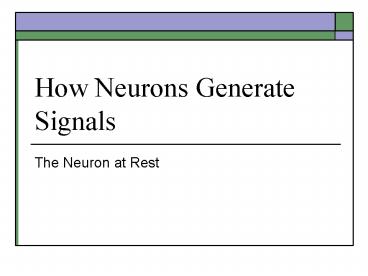How Neurons Generate Signals - PowerPoint PPT Presentation
1 / 9
Title:
How Neurons Generate Signals
Description:
Nernst equation calculates the equilibrium potential for a single ion, given ... Goldman equation calculates the resting potential of a neuron, given knowledge ... – PowerPoint PPT presentation
Number of Views:25
Avg rating:3.0/5.0
Title: How Neurons Generate Signals
1
How Neurons Generate Signals
- The Neuron at Rest
2
Stepping on a Thumbtack
- Reflexive withdrawal of the foot a simple
behavior controlled by a circuit with direct
connections between - Sensory neurons (responding to environment)
- Motor neurons (controlling muscles)
- Interneurons (to inhibit opposing muscles)
- Projection neurons (carrying sensation to the
brain) - Messages are carried via action potentials.
3
Biochemical Reactions
- Ion an electrically charged atom.
- Polar covalent bonds a molecule held together
by sharing electrons (H2O). - Ionic bond a molecule held together by the
attraction of atoms with opposite charges (NaCl
table salt). - Cation ion with a net positive charge.
- Anion ion with a net negative charge.
4
The Neuron at Rest
- Neurons have potassium (K) inside and sodium
(Na) outside in the extracellular fluid. - Ion channels in the cell wall (membrane) are
selectively permeable to potassium, sodium or
calcium. - Ion pumps maintain the cells inner environment.
5
How Ions Cross the Membrane
- Diffusion an ionic concentration gradient
exists - Differences in electrical membrane potential and
equilibrium potential - Ionic driving force
- Ion pumps
- Sodium/potassium, calcium
6
Electricity
- Opposite charges attract, like charges repel.
- Current (I) movement of electrical charge,
measured in amps. - Potential (voltage, V) force exerted on a
particle, difference between terminals, measured
in volts. - Conductance (g) relative ability of a charge to
migrate, measured in Siemens.
7
Resting Potential
- Membrane potential is voltage across the neuronal
membrane. - Resting potential is the point at which all of
the forces acting upon ions are in balance
(equilibrium). - Diffusional and electrical forces are equal.
- Vm -65 mV
8
Two Important Equations
- Nernst equation calculates the equilibrium
potential for a single ion, given knowledge of
its concentration inside outside the neuron. - Varies with body temperature.
- Goldman equation calculates the resting
potential of a neuron, given knowledge of its
permeability to various ions. - Varies with ion concentrations.
9
Regulation of Potassium
- The neuron at rest is mostly permeable to
potassium (K) so the resting potential is close
to EK. - Increasing potassium outside the cell leads to
depolarization (an increase in the resting
potential making it less negative). - To prevent this, potassium is tightly regulated
by the body via glia blood-brain barrier.































